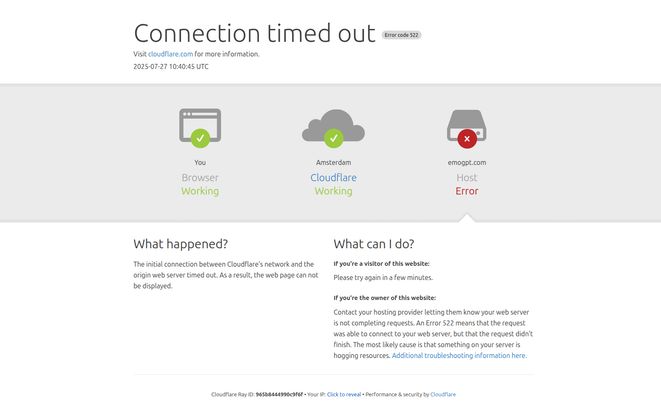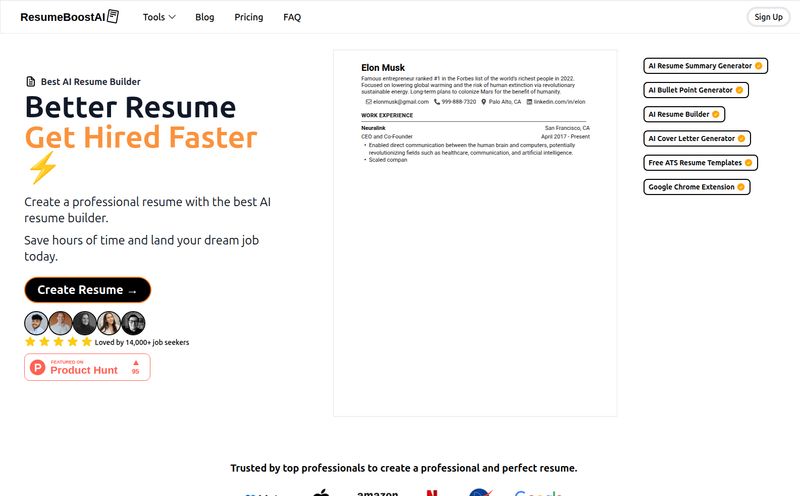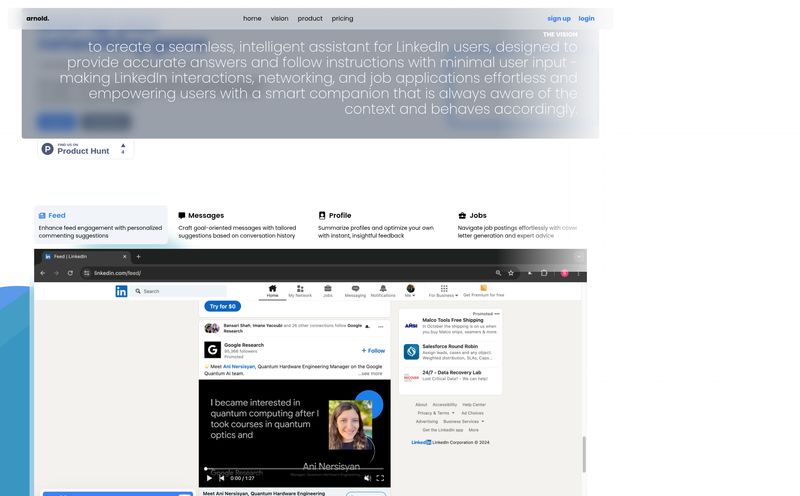As someone who’s spent more years than I care to admit staring at analytics, tweaking campaigns, and writing enough content to fill a small library, I get excited by new tools. Especially tools that promise to solve a real, nagging problem. So when I heard about EmoGPT, my ears perked up. A free, privacy-first ChatGPT extension for Gmail? Sign me up. It sounded like the perfect antidote to the endless churn of crafting the 'perfect' email response.
I grabbed my coffee, cracked my knuckles, and navigated over to their website to give it a spin for a proper review. And I hit a wall. A digital brick wall, to be precise. A Cloudflare Error 522: Connection timed out.
Huh.
Is it a temporary server burp? Or has EmoGPT become a digital ghost? This isn’t just a review anymore; it’s turned into a bit of a mystery. Let’s dig into what this tool promised and what its current state tells us about the wild west of free AI software.
So, What Was EmoGPT Supposed to Be?
Before we get all doom-and-gloom, let's talk about the idea, because honestly, the idea is solid. EmoGPT was designed to be a simple browser extension that lives inside your Gmail. Its one job was to take the heavy lifting out of writing emails. Think of it as a little AI ghostwriter sitting on your shoulder, ready to whip up a personalized reply, a polite follow-up, or even a cold outreach email from a simple prompt.

Visit EmoGPT
It taps directly into the power of OpenAI’s ChatGPT, which we all know can be incredibly powerful for generating human-like text. The goal was to make your email workflow faster and more efficient, without you having to constantly switch tabs to a separate AI chat window. For anyone in sales, marketing, or even just management, the potential time savings are pretty obvious. It’s the kind of simple, focused utility that I love to see.
The Big Deal About Privacy (And Why It Mattered)
Here’s where EmoGPT really caught my eye. In an age where every free extension seems to want to read your browsing history, access your contacts, and probably know what you had for breakfast, EmoGPT went in the opposite direction. Its main selling point was privacy. The developers claimed it didn't request any invasive permissions. That's a massive green flag for me.
But the real kicker was the ability for users to plug in their own OpenAI API key. Now, this might sound a bit technical, but it’s a game-changer. Let me break it down:
- When a tool offers a "free" AI service, they are usually paying for the API calls on their end. This means your data (the emails you're writing, the prompts you're using) is passing through their servers. Who knows what they do with it.
- By letting you use your own API key, EmoGPT was essentially just creating a bridge between you and OpenAI. Your data goes from your computer to OpenAI and back. The middleman—EmoGPT—doesn't store it, see it, or train its models on it. You have full control over your data within your own OpenAI account.
This is the kind of thoughtful design that builds trust. It showed they understood a major hesitation people have with integrating AI into sensitive workflows like email. It wasn't just another data-slurping machine disguised as a helpful tool.
The Good, The Bad, and The… Well, The Missing
Let's lay it all out. Every tool has its ups and downs, but EmoGPT’s list is a little more dramatic than most.
The Good Stuff
The pros were pretty compelling. First, it was free. Can’t beat free. The privacy focus, as I've mentioned, was a huge plus. And its direct integration into Gmail promised a genuinely smooth user experience. No muss, no fuss. It was a tool built to do one thing and do it well, right where you needed it.
The Not-So-Good Stuff
Of course, nothing is perfect. Its biggest weakness was its reliance on OpenAI. If ChatGPT is having a bad day (and we’ve all seen it happen), then EmoGPT is effectively useless. You’re at the mercy of another company’s uptime. There was also a little note in their description about how "advanced features may require additional resources in the future." To a seasoned marketer, that's code for, "We're going to introduce a paid plan eventually." Which is fair! But it’s something to be aware of.
The Current Reality
And that brings us to today. The biggest con of all is that the service appears to be completely offline. That Cloudflare 522 error isn't just a simple "page not found"; it means the browser could connect to Cloudflare's network, but Cloudflare couldn't get a response from the EmoGPT server. This could be due to a number of things—the server is overloaded, it crashed, or perhaps the hosting bill wasn't paid. It's a reminder that relying on smaller, free tools can be a gamble. They can disappear without a trace, leaving you high and dry.
Is EmoGPT Still a Viable Option?
Right now? It's hard to say yes. You can't use a tool you can't access. I'm holding out a little hope that this is a temporary outage and the developer will get it back online. The concept is too good to just let it fade away.
However, this situation is a fantastic lesson in the lifecycle of software products. Especially in the gold rush of AI tools we're seeing right now, many are built by small teams or even single developers. They might be passion projects or attempts to build a user base quickly. But without a solid business model, they can be fragile. A change in personal circumstances or a larger-than-expected server bill can take them down.
If you're looking for a reliable AI email assistant for your business, this might be a sign to look at more established players or projects with more transparent funding and support, even if they cost a few bucks a month. Reliability, after all, is a feature worth paying for.
What If It Comes Back? A Look at the Price
The pricing for EmoGPT was its most attractive feature: it was free. This was likely possible because of the BYOAK (Bring Your Own API Key) model. It put the minuscule cost of API calls onto the user (which, for most individuals, is pennies), while the developer just had to maintain the extension itself.
But as we're seeing, "free" doesn't always pay the server bills. It's a classic double-edged sword. While it attracts a ton of users, it provides no revenue to ensure the project's long-term survival. If EmoGPT does make a comeback, I wouldn't be surprised to see a 'Pro' plan that offers extra features for a small monthly fee. And honestly, if the tool works as promised, I think that would be a fair trade for sustainability.
FAQs About EmoGPT
- What exactly is EmoGPT?
- EmoGPT is (or was) a free browser extension for Gmail that used OpenAI's ChatGPT to help you write and reply to emails quickly. Its key features were a focus on user privacy and the ability to use your own OpenAI API key.
- Is EmoGPT actually free to use?
- Yes, the extension itself was free. However, it was designed to work best if you used your own OpenAI API key, which could incur very small costs from OpenAI depending on your usage, though many users would fall within OpenAI's free tier.
- How did EmoGPT protect my privacy?
- It claimed to not request invasive permissions and, most importantly, allowed you to use your own API key. This meant your email content was not processed or stored on EmoGPT's servers, creating a direct and more private link between you and OpenAI.
- Why can't I access the EmoGPT website?
- The website is currently showing a Cloudflare Error 522, which indicates a problem with its host server. It's unclear if this is a temporary technical issue or if the service has been discontinued permanently.
- Does EmoGPT work without ChatGPT?
- No. The entire platform was built on top of OpenAI's ChatGPT. It was the engine that powered all of EmoGPT's text generation features. If ChatGPT is down, EmoGPT would not work.
- Are there any good alternatives to EmoGPT?
- Absolutely. The AI writing space is crowded. For in-email assistance, tools like Grammarly's AI features, an AI writing platform like Jasper, or even dedicated email tools like Ortto have robust AI capabilities, though most come with a subscription fee.
A Promising Idea, A Cautionary Tale
I started out wanting to review a cool new tool and ended up investigating a digital mystery. I'm genuinely disappointed that EmoGPT is down. The world needs more privacy-conscious software, and the idea was brilliant in its simplicity. I’m still rooting for tools like this, built with the user's best interests at heart.
But its current absence is a potent reminder for all of us in the tech and marketing space. When you build your workflow around a free tool, you're also inheriting its risks. Sometimes, the most valuable feature isn't the bells and whistles, but simply knowing the lights will still be on tomorrow. Here's hoping someone gets the server rebooted soon.
Reference and Sources
- Cloudflare - Understanding the Error 522 Connection Timed Out.
- OpenAI - Information on the API used by tools like EmoGPT.



